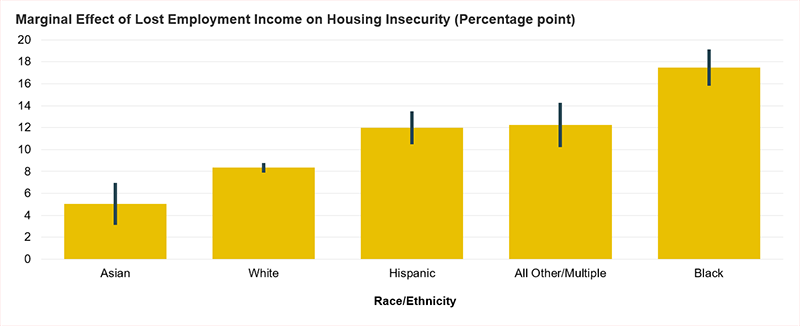During the pandemic, as lockdowns to reduce the spread of COVID-19 prompted widespread loss of work, millions of renters and homeowners fell behind on their housing payments.
In a new study from the Joint Center for Housing Studies, an article “COVID-19 and Racial Inequalities in Housing: Pre-Pandemic and Pandemic Pathways to Housing Insecurity,” published in the Journal of Urban Affairs, shows how Black, Hispanic, and Asian households disproportionally fell behind on housing payments during the pandemic.
New data found the higher likelihood of having late payments were partially a byproduct of pre-pandemic inequalities, but the systemic shock of the pandemic aggravated existing racial and ethnic disparities.
Analyzing data from the Household Pulse Survey, a nationally representative survey by the U.S. Census Bureau, Black (23%), Hispanic (18%), and Asian (15%) households were far more likely than white households (8%) to fall behind on housing payments between August and December 2020. Black renters were most vulnerable, with one in four Black renters (26%) reporting being behind on rent.

Higher rates of housing insecurity for households of color were partially a byproduct of racial disparities that preceded the pandemic, such as lower homeownership rates, incomes, and education levels. For example, 66% of white households in our sample owned their homes, compared to 46% of Hispanic and 39% of Black households.
However, the pandemic itself also shaped new inequalities in who became vulnerable to housing insecurity due to differences in who worked in the most-impacted industries, underlying health disparities, and the geographic variation in COVID-19. Research highlights how broader social crises like pandemics, recessions, political turmoil, or climate disasters—called systemic shocks—have the potential to disrupt existing patterns of social stratification and tend to exacerbate those inequities.
Pre-Pandemic and Pandemic-Induced Vulnerabilities Both Shaped Racial Inequalities in Housing Insecurity
Specifically, we found that Black and Hispanic households were far more likely to suffer from the financial fallout of the pandemic. Indeed, more than half of Black and Hispanic households lost employment income at some point between March 2020 and the end of the year compared to about two-fifths of white households. Moreover, we found that Black and Hispanic households were more likely to fall behind on their rent or mortgage payments in the aftermath of losing employment income.
In the paper, regression models were used to better understand how changes in some characteristics—such as losing employment income—were associated with a households’ ability to keep up with their housing payments while controlling for other characteristics.
These methods account for other differences that exist by race and ethnicity (like pre-pandemic vulnerabilities) that also influence the likelihood a household fell behind on their payments.
After Losing Income, Black Households Were More Likely to Become Housing Insecure Than Other Groups
Predictions from these models suggest that a Black household with lost employment income and otherwise average characteristics would have a 28% chance of falling behind on their payments, 18 percentage points higher than those who did not lose employment income.
By comparison, we predicted a 12 percentage point increase in housing insecurity for Hispanic, 8 percentage point increase for white, and 5 percentage point increase for Asian households with lost employment income.
In other words, not only were Black and Hispanic households more likely to lose employment income in the second half of 2020, but they were significantly more likely to face housing insecurity when they lost income.
To read the full report, including more data, charts, and methodology, click here.

 theMReport.com Your trusted source for mortgage banking news
theMReport.com Your trusted source for mortgage banking news








